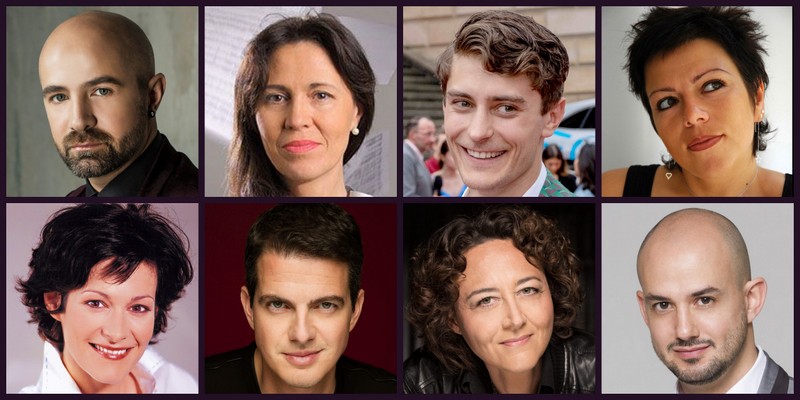Recently I discovered a YouTube channel Baroque and Beyond, created by someone who in the ABOUT section writes: My channel mostly focuses on Baroque operatic music. You may know by now that I am very interested in Baroque Operas, so I immediately subscribed to this channel. It is a real treasure trove.
One playlist of the channel, containing more than 60 videos, is named Who sings it best? Each video has several recordings of the same aria, sung by different singers. Of course “best” must not be taken seriously, they all are professionals, but it is interesting to compare them, and each music lover will have her/his own preference.
Here are a few of the singers. Top row, from left tp right Max Emanuel Cenčić, Sara Mingardo, Jakub Józef Orliński, and Sonia Prina. Bottom row, from left to right Marijana Mijanovic, Philippe Jaroussky, Nathalie Stutzmann and Franco Fagioli.

What they have in common is that their vocal range is basically the same! The men are countertenors, the women contraltos. Wikipedia gives for both an identical vocal range, two octaves, here marked in green. on a keyboard, the key with a dot is the central C-key.

In Baroque operas, the leading male roles were almost never sung by a tenor or a bass, but generally by a castrato or a contralto in a “trouser role“. As there are no castrati anymore, countertenors have taken their place. That is why in many of the Who Sings It Best videos you can listen to a mixture of countertenors and contraltos.
Here is an example, Who sings Vivaldi’s “Vedrò con mio diletto” best?, sung by two countertenors, two contraltos and one mezzo-soprano. In the opera .Il Giustino (1724) the emperor Anastasius sings this aria as a love song for his wife Ariadne. Wouldn’t you expect a tenor to play this role?
In Handel’s opera Rodelinda (1725) the role of king Bertarido was originally sung by an alto castrato. His famous aria “Dove sei, amato bene” is a love song for his wife Rodelinda. In Who sings Händel’s “Dove sei, amato bene” best? it is sung by five countertenors. If you like contrasts, listen also to this recording by mezzo-soprano Marilyn Horne. Not my favourite 😉
Here is an aria from another Handel opera, Oreste (1734). The opera is a so-called “pasticcio” in which Handel assembled arias from his earlier operas into a new one. In this case the story of Orestes and his sister Iphigeneia. In 1734 Orestes was sung by a famous castrato. In Who sings Händel’s “Agitato da fiere tempeste” best? , the aria is sung by three countertenors and two contraltos, from left to right Orlinski, Mingardo, Stutzmann, Jaroussky and Fagioli.

Finally here is an aria sung by another king in Vivaldi’s opera Farnace (1727) , Farnace, King of Pontus, has been defeated by the Romans and commands his wife to kill their son, so he will not fall in the hands of the victors. No love song, but a tragic aria, originally sung by a contralto en travesti. Here are the lyrics of the aria, in an English translation.
Cold in every vein
I feel the blood flow
The shadow of the lifeless son
I am filled with terror
And for my greater pain
I see I was cruel
To an innocent soul
At the heart of my heart
In Who sings Vivaldi’s “Gelido in ogni vena” best? this beautiful aria is performed by two countertenors, a contralto, a mezzo-sorano, a soprano and even a tenor!. Compare which recording you prefer.
Actually the best recording (in my opinion) is not in this list. Listen to Countertenor Christopher Lowrey. Absolutely breathtaking, it gives me goosebumps.
I will end this blog with a few Who Sings It Best videos that don’t fit in the countertenor/contralto category.. For a variety of reasons.
In Who sings Porpora’s “Torbido intorno al core” best? Two countertenors and a contralto sing an aria from Porpora’s opera Meride e Selinunte (1727) , But here they sing an aria of Ericlea, a female!. In those days the modern concept of gender identity probably was not yet developed ;-). Porpora was famous in his days,, see my blog Countertenors and Castrati, for more info about him..
Then there is Who sings Vivaldi’s “Armatae face et anguibus” best?, The aria is from Vivaldi’s oratorio Juditah Triumphans (1717), performed in this video by sopranos and mezzos, but in the libretto the aria is sung by Vagaus, a eunuch! He sings this furious aria when he discovers that Juditha has murdered his master Holoferenes in his sleep. The Who Sings it Best videos are actually audios. Watch here the fury of Cecilia Bartoli in a real video.
And finally Who sings Vivaldi’s “Cum dederit” best? Vivaldi composed Nisi Dominus between 1703 and 1739. Not an opera and Cum Dederit is not an aria. Sung in the video by four countertenors and two mezzo-sopranos. Surprisingly the best recording (again in my opinion) is left out! Watch here Andreas Scholl
